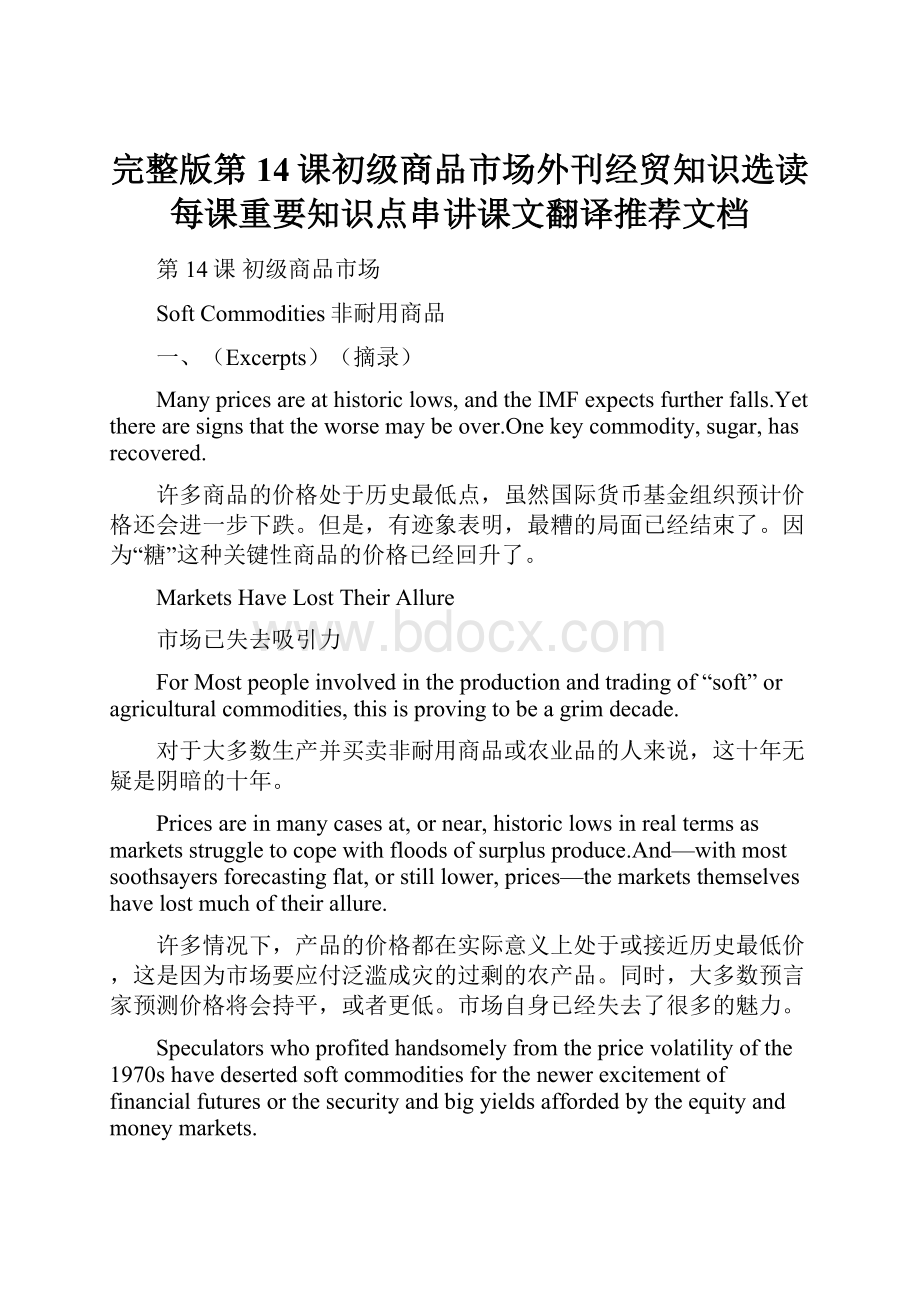完整版第14课初级商品市场外刊经贸知识选读每课重要知识点串讲课文翻译推荐文档.docx
《完整版第14课初级商品市场外刊经贸知识选读每课重要知识点串讲课文翻译推荐文档.docx》由会员分享,可在线阅读,更多相关《完整版第14课初级商品市场外刊经贸知识选读每课重要知识点串讲课文翻译推荐文档.docx(16页珍藏版)》请在冰豆网上搜索。

完整版第14课初级商品市场外刊经贸知识选读每课重要知识点串讲课文翻译推荐文档
第14课初级商品市场
SoftCommodities非耐用商品
一、(Excerpts)(摘录)
Manypricesareathistoriclows,andtheIMFexpectsfurtherfalls.Yettherearesignsthattheworsemaybeover.Onekeycommodity,sugar,hasrecovered.
许多商品的价格处于历史最低点,虽然国际货币基金组织预计价格还会进一步下跌。
但是,有迹象表明,最糟的局面已经结束了。
因为“糖”这种关键性商品的价格已经回升了。
MarketsHaveLostTheirAllure
市场已失去吸引力
ForMostpeopleinvolvedintheproductionandtradingof“soft”oragriculturalcommodities,thisisprovingtobeagrimdecade.
对于大多数生产并买卖非耐用商品或农业品的人来说,这十年无疑是阴暗的十年。
Pricesareinmanycasesat,ornear,historiclowsinrealtermsasmarketsstruggletocopewithfloodsofsurplusproduce.And—withmostsoothsayersforecastingflat,orstilllower,prices—themarketsthemselveshavelostmuchoftheirallure.
许多情况下,产品的价格都在实际意义上处于或接近历史最低价,这是因为市场要应付泛滥成灾的过剩的农产品。
同时,大多数预言家预测价格将会持平,或者更低。
市场自身已经失去了很多的魅力。
Speculatorswhoprofitedhandsomelyfromthepricevolatilityofthe1970shavedesertedsoftcommoditiesforthenewerexcitementoffinancialfuturesorthesecurityandbigyieldsaffordedbytheequityandmoneymarkets.
从20世纪70年代的价格不稳中大笔获益的投机者们已经放弃了非耐用商品而寻求金融期货或有价证券带来的新的刺激以及股票和货币市场提供的巨额利润。
Thecontrastwiththe“resourcesdecade”ofthe1970scouldhardlybemoremarked.Itisstrange,indeed,toobservethatonly10yearshaveelapsedsincespiralingcommoditypriceswerethefocusofmajorinternationalconcern,andmanyrespectedforecasterswerewarningofimpendingglobalshortagesofbasicrawmaterialsandfoodstuffs.
这和70年代的“资源十年”之间的对比是再明显不过的了。
确实很奇怪,仅仅十年前,国际上关心的焦点还是不断盘旋上升的价格,许多受人尊重的预言家们一直在警告全球性的基础原材料和食品短缺即将到来。
Theshortagesnevercame,andthetermsoftradehavenowshifteddramaticallyagainstthecommodityproducers.Agriculturalcommoditieshavebeenparticularlybadlyhit.Lastyearalone,theInternationalMonetaryFund’sindicesoffoodpricesandofagriculturalrawmaterialpricesfellby15percentand12percentrespectively.Commoditypricesingeneralwereabout35percentbelowtheir1980averagein1985accordingtotheUNConferenceonTradeandDevelopment(UNCTAD).
然而,短缺从未出现,现在的贸易条件已经转为对商品生产者大为不利,特别是农产品遭到了严重的打击。
仅仅去年一年,国际货币基金组织的食品和农业原材料的价格指数就分别下跌了15%和12%。
联合国贸易和发展会议(贸发会)的资料显示,总体上,1985年的商品价格比1980年的平均值大约低35%。
Whatismore,currencymovementsoverthepastyearhaveunexpectedlymademattersworseformanyproducers.Inthefirsthalfofthe1980s,itwasconventionalwisdomtosaythattheexceptionalstrengthofthedollarwaspartlyresponsiblefor—andhelpedtooffset—theincreasingweaknessofdollar-denominatedcommodityprices.Allotherthingsbeingequal,sotheargumentwent,asubsequentfallinthedollarmightbeexpectedtogiveacompensatingboosttodollarcommodityprices.
而且,过去一年中的货币动态出人意料地把许多制造商的事情搞得更糟。
80年代的上半期,人们普遍认为,美元的异常坚挺部分地导致了——同时也有助于弥补——以美元标价的商品价格的日益降低。
因此,又有观点说,在其他条件都不变的情况下,美元日后的下跌可能会补偿性地提高以美元标价的商品的价格。
Butnowthedollarhasfallen,andtheveryreversehashappened:
commoditypriceshavecontinuedtotumblefromthepeaktheyreachedinthesecondquarterof1984.whencalculatedinamorerepresentativebasketofcurrencies,suchastheSpecialDrawingRight,thefalllooksevenmoreprecipitous.InMayofthisyear,forexample,theIMF’sfoodpriceindexwasafurther10percentbelowitslevelinthesecondquarterof1985.
可是现在美元已经贬值,结果恰恰相反的情况出现了:
商品的价格继续从1984年第二季度所达到的高峰暴跌。
如果以一个更有代表性的“一篮子”货币来计算,比如,特别提款权,这一下跌就显得更为急促。
以今年五月为例,国际货币基金组织的粮食价格指数比1985年的第二季度就又下降了10%。
Therearesignsthattheworstofthefallmaynowbeover;indeed,onekeycommodity,sugar,hasreboundedimpressivelyfromthelowsoflastyear,thougheventhesugarpriceremainsbelowthemostefficientgrower’scostofproduction,anditsrallyappearstohaverunoutofsteam.Fortherest,nobodyisboldenoughtoforecastamajorimprovementeitherthisyearornext.TheIMF,foritspart,believesthatthepricesofmostcommoditieswillfallsubstantiallyin1986—withonlysugar,tropicaltimberandhidesamongthesoftslikelytorisesignificantly.
有迹象表明,最严重的下跌可能已经过去了;确实,“糖”这种主要商品已经从去年的低谷中有了显著的回升。
虽然它的价格仍然低于最高效的种植者的生产成本,它的跌停回升好像已经失去了动力。
对于其他初级商品,没有人敢妄言在今年或明年会有大的改观。
而国际货币基金组织认为,大多数的商品都会在1986年大幅下跌,非耐用商品中,只有糖、热带木材和皮革可能会有显著上升。
(但是,对等贸易并不是债务国所独有的。
约非说:
“即使像澳大利亚、加拿大和印度尼西亚这样外汇地位强健的国家也坚持在某些领域从事对等贸易。
把进口和出口联系起来是一种对跨国公司施加权力的途径。
缺乏国际营销专业知识的国家试图用对等贸易作为杠杆来推动跨国公司的内部市场网络。
”)
“Thebehaviourofcommoditypricesis,tosaytheleast,bewildering,”remarketMrAlisterMclntyre,theactingheadofUNCTAD,atarecentmeetingofthebody’scommoditiescommittee.
贸发会的代理秘书长阿里斯特?
迈克因特尔先生在该组织的初级商品委员会最近一次会议上说,“至少可以说,商品的价格行为令人迷惑。
”
Tomanydevelopingcountries,thetrendisdeeplyworryingaswellasbewildering—thetermsoftradehaveworseneddramaticallyforthem.Between1980and1985,theirexportearningsfromanIMF-selectedsampleof17commoditiesdroppedby16percent.
对于许多发展中国家而言,这种趋势不仅令人迷惑,还令人深深地担忧——贸易条件对于他们已经明显恶化。
1980到1985年间,从国际货币基金组织抽取的17种商品样品来看,他们的出口收人下降了16%。
Fortheindustrializedworld,bycontrast,thedropincommoditypriceshasbeenarealbooninthefightagainstinflation.AsLloydsBankcommentedrecently:
相反,对于工业化国家而言,商品价格的下跌是他们在对抗通货膨胀中得到的及时的恩赐。
正如劳埃德银行最近评说的:
“Theweaknessofdollarcommodityprices,combinedwiththedeclineofthedollar,ishavinganimportantrestraininginfluenceoninflationinmanyindustrialcountries.EvenintheUnitedStates,whereafallingdollarwouldtendtoboostinflation,weakcommoditypriceshavehelpedtopreventrelativelyrapidGNPgrowthfrombeingaccompaniedbyacceleratinginflation.”
“以美元标价的商品的疲软,再加上美元的下跌,对许多工业国家的通货膨胀起到了重要的抑制作用。
即使在美国,贬值的美元容易助长通货膨胀,疲软的商品价格有助于防止国民生产总值相对较快增长的同时出现通货膨胀加快的现象。
”
Theexplanationforthegeneralweaknessincommoditypricesiscomplex,andthefactorsinplaywillobviouslyvarygreatlyfromonecommoditytoanother.
商品价格普遍疲软的原因是复杂的。
作用的因素也很明显地区别于一种商品和另外一种商品。
Coffee,forexample,hasprovedtobeanexceptiontothedecliningtrendoverthepastninemonths,becauseofadroughtinthebiggestproducingcountry,Brazil.
例如咖啡,在过去的9个月中实属例外,因为它最大的生产国,巴西遭遇了一场干早。
Inthecaseofsome“temperate”agriculturalproducts,suchasthegrains,ontheotherhand,thereisaparticularlysevereglutofsupplies,andworldmarketpricesarecontinuingtodeclineundertheinfluenceofaprice-cuttingwarbetweentheUSandtheEEC.TheUSisalsosettingoutthisyeartoarrestthedeclineinitsexportsofsoyabeans,cotton,tobaccoandrice—withpotentiallydevastatingconsequencesformanyproducersofthesecommoditiesintheThirdWorld.
另一方面,对于一些价格相对平稳的农产品来说,比如谷物,出现了特别严重的供给过剩现象。
其世界市场价格在美国和欧共体削价大战的影响下不断下跌。
美国今年还要着手阻止大豆、棉花、烟草和大米的出口量的下滑——可能会给生产这些产品的许多第三世界国
家带来毁灭性的后果。
Therearealsodeepuncertaintiesabouttheeffectsofthemostdramaticcommoditypricecrashofthemall—thatinthecrudeoilmarketoverthelastyear.Whilefallingoilpricesoughttoprovideafilliptowesterneconomicgrowth—andtherefore,indirectly,todemandforothercommodities—theyareboundtohaveother,perhapslessdesirable,spin-offs.
商品价格最显著的暴跌要算是去年的原油市场了。
它所造成的影响也很难确定。
按理说,下降的油价应该会刺激西方经济的增长——因此,会间接地刺激对其他商品的需求,然而,它也肯定会带来其他不太受人喜欢的副产品。
Forproducersofrubberandnaturalfibressuchascottonforexample,thedropintheoilpriceisboundtomeanincreasedcompetitionfromsyntheticproducts.Inteaandsugar,tonamebuttwoothercommodities,itisalreadytakingitstollinthefromofreducedpurchasesbycash-strappedoil-producingstates.
对于橡胶和诸如棉花等天然纤维的生产商来说,石油价格的下跌肯定意味着来自合成产品的竞争的加强。
只要再举出两种初级商品,比如茶叶和糖就可以说明问题。
它们的生产商已经因为现金短缺的产油国压缩购买而遭受损失。
Nevertheless,severalcommonfeatures—whichwouldapplytometalsandminerals,justasmuchastosoftcommodities—canbeidentified.
然而,几个共同特点-—可以适用于金属和矿产品,也可适用于非耐用商品—是可以识别的。
First,worldeconomicgrowthremainsgenerallysluggishandhasbeenatitsweakestinmanufacturing,asopposedtotheservicessector.UncertaintiesoverthefutureoftheUSrecoveryandslowgrowthinEuropearekeepingdemandforkeyindustrialrawmaterialsrelativelydepressed.Inmanyofthenewerandheavily-indebtedindustrialcountries,commodityconsumptionhasbeensqueezed,asaresultofofficialausterityprogrammes.
首先,世界经济的增长总体上仍处在萧条状态,其中,制造业最弱而服务部门却恰恰相反。
美国未来经济复苏的不确定性和欧洲经济的缓慢增长一直压抑着对主要工业原材料的需求。
在许多新兴或负重债的工业国家中,商品消费因为官方的简朴计划而被压缩。
Second,developingstateshavehadtomaximizecommodityexportsinordertokeepuptheirforeignexchangeearningsandoffsetthedeclineinunitcommodityprices.This,inturn,hasaggravatedoversupplyproblems.ItistrueofChileinthecoppermarket,asitisofBrazilinsoyabeansorMalaysiainpalmoil.
其次,一些发展中国家不得不最大量地加大商品出口,以保持他们的外汇收人并补偿商品单价的下降。
这样转而加剧了供给过量的问题。
智利在黄铜市场上如此,巴西在大豆市场上,马来西亚在棕桐油市场上也是如此。
Third,theworldhasgotusedtolivingwithmuchlowerlevelsofstocksthanintheinflationary1970s.Ontheonehand,thepersistenceofhighrealinterestrateshasincreasedthecostofcarryinglargeinventories,andconsumersare,inanycase,quitehappytodeferpurchasewhenpricesareonthewaydown.
第三,世界已经习惯了比70年代的通货膨胀时期低得多的库存量。
一方面,持续的高实际利率增加了运送大批存货的成本;另一方面,消费者们无论如何都十分乐意等到价格下降时再购物。
Fourth,investmentfundshavemovedoutofcommodities—whichwereboughtinthe1979sasstoresofvalue—andintomoreliquidassets,Traderscomplainaboutalackofpricevolatility;severalmarketsspeakoftheneedtoattractbackspeculativebusiness—andofthedifficultyofdoingsointhepresentclimate.Gonearethedayswhenthefocuswasonpossiblemarketdistortionsresultingfromexcessivespeculativeactivity.
第四,投资资金已经从商品中撤出来—20世纪70年代人们购买商品作为价值储存——现在,资金投到了更易变卖的资产上来。
贸易者们抱怨价格缺乏变化;一些市场提到需要把投机生意吸引回来——同时也提到在目前的情况下这样做的困难。
那些关注于过多的投机行为可能引起市场混乱的日子已经一去不复返了。
Finally,andperhapsmostsignificantly,thereisevidenceofamorefundamentalshiftinthepatternofsupplyanddemandforanumberofcommodities,andofalong-termdownwardtrendincommodityprices.Lookedatfromthisperspective,thescarcityworriesofthe1970sweremerelyatemporaryaberrationresultingfromasuddenspurtofeconomicgrowtha